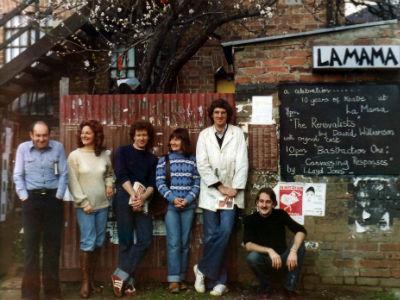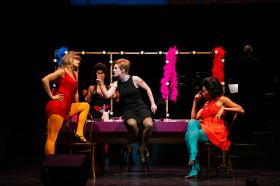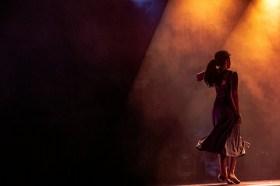If creativity is the single most important driver of both economic growth and a rich and interesting life, why is it under such a short-sighted assault by both sides of the political divide?
The state governments of Queensland, New South Wales and Victoria are hell bent on ripping money out of the TAFE system and the area in which the cuts are most savage are the creative arts. Creative courses on university campuses are under just as much threat, but here it’s not the bloody minded anti-arts mentality of conservative state governments that’s to blame but the gradual python squeeze of less and less university funding for which the federal government must take the blame.
Despite increases in university funding by the Labor Government, these increases have not kept up with inflation or increasing student load and in essence our universities are asked to do more with less. Funding levels for higher education have dipped to just 0.7 percent of GDP as against the OECD average of 1 percent.
The funding squeeze on universities affects all areas of study adversely but the creative arts tend to suffer the most. There are several reasons why the creative faculties tend to do badly when money is short, even when it’s known that the arts sector contributes $30 billion a year to the GDP, more than agriculture, forestry and fishing combined.
Funding in a university flows from the number of students you teach and how effective you are as a research institution. Many faculties have responded to funding pressures by decreasing the staff student ratio. Tutorials of a dozen were commonplace thirty years ago, now the normal size is thirty. While this has decreased the effectiveness of teaching in all faculties, it’s still possible in most of them to get an acceptable outcome.
In creative pursuits, however, learning is only partly possible by discussion; it’s actually doing the activity, and getting precise and informed feedback from talented teacher/practitioners that enables a student to flourish. Industrial design students must design, then be assessed by a top grade practitioner if they are to learn.
In creative arts the teaching often has to be one-on-one. The experienced and talented practitioner must give honest and valuable feedback to the student. There’s no other way. In first year Physics at Melbourne University, I sat in a lecture theatre with two hundred and fifty other students and was still able to make reasonable sense of it. With the arts, that kind of teaching is fruitless. Staff student ratios can’t dip below a necessary level which makes creative arts an often expensive discipline to teach.
Often space and infrastructure needs are larger in creative arts training than in other faculties. You can’t teach dance in a tutorial room. And you need a sprung floor to make sure your dancers survive into their second year.
You can’t teach javelin throwing in a tutorial room either, but in the arena of sport, high quality one on one teaching and hugely expensive facilities are par for the course and never begrudged by governments. The overall cost of our Olympic gold medals was in excess of $17 million dollars per medal but that was thought to be not nearly enough investment by many who oversee our elite sports institutions. Why as a society we think it’s legitimate to spend huge amounts on our sportsmen and women, but seemingly don’t think the relative pittance we spend on developing a potential Cate Blanchett or Geoffrey Rush is as justifiable, has to say something about our national and political priorities.
The second major difficulty of creative arts teaching, when it comes to the political scramble for the campus dollar, is that research is not a top priority.If you’re training students in classical dance, you don’t want them spending huge amounts of time researching and publishing a learned academic paper on “Nuances in the eighteenth century pirouette”. You’d prefer them to be out on the dance floor actually doing pirouettes.
While high costs per student and meagre research output don’t help the creative faculties in the ferocious rough and tumble of funding advocacy, there’s another factor that I think unconsciously biases many against creative arts funding.
I once heard myself being used as an argument against funding for creative training…“Funding for creative writing courses is a load of crap. You graduated as an engineer and you became a playwright.” This kind of attitude stems from a belief that some of us are born with great creative talent that will flower under any circumstances, that the creative act is spontaneous, a divine spark that has to be expressed, and will appear fully formed as an inevitable consequence of inborn genius.
Looking at the history of creative writing, nothing could be further from the truth. Some people may be more innately gifted than others but without a testing ground and lots and lots of feedback and mentoring, that talent will find it hard to develop.
The London of Shakespeare’s time contained roughly two hundred thousand people. A tiny city by today’s standards, but out of that tiny city came not only Shakespeare, but Ben Jonson, Christopher Marlowe, John Webster, Thomas Middleton, Francis Beaumont and John Fletcher, Robert Greene and many other talented playwrights.
Why? Because they had a brilliant opportunity to learn their craft. There were a dozen theatres operating in London doing six plays a week, and the need for new material to feed the five thousand avid audience members daily was intense. Playwrights checked out each other’s work, stole from each other, discussed their work endlessly, changed venues regularly and had their work intensely critiqued by the hard-worked actors who had to perform it under huge pressure and who didn’t hesitate to tell the writers exactly what they thought. In short, the conditions for learning a trade were perfect and it’s no accident that playwrights were called playwrights for the same reason ship builders were called shipwrights. Playwrights didn’t sit around waiting for the divine muse to awaken their genius. Like shipwrights they hammered their lines together till they added up to a reasonable evening in the theatre. In short, Elizabethan England unwittingly was a creative writing course par excellence.
I was lucky enough to be part of a mini-Elizabethan London when small theatres sprang up around Carlton in the late sixties and early seventies, determined to find and express Australian voices, something almost totally absent from our own main stages which then overwhelmingly did English and American plays with the odd one from Europe.
What happened in Shakespeare’s time is exactly what the best creative writing courses do now. They make students produce work not occasionally but often, and then have that work subjected to the beadle-eyed scrutiny, not just of their teachers, but their fellow students.
Creativity has to be learned just like anything else.
Australia is blessed with some of the world’s best in their respected fields and their collaborative efforts have not only given pleasure to millions of people. These people didn’t come to their roles by accident. They had the benefit of a rigorous training that helped them become the true professionals they are today. People like Cate Blanchett, Geoffrey Rush, Hugh Jackman, Judy Davis, Hugo Weaving, Robyn Nevin and Baz Lurhmann are all well-known Australians who started their careers in a university or institute that specialised in high quality education.
The same applies to many other creative art forms: the visual arts, dance and music. Some of Australia’s leading contemporary writers have attended writing courses to learn the skills of writing or to complete postgraduate studies to enhance their writing and complete a new work. These include Kate Grenville, Sue Wolfe, Anna Funder, Pam Newton, Camilla Nelson, James Bradley, Catherine Cole, John Dale and Ashley Hay. Internationally, Ian McEwen and Kazuo Ishiguro both studied creative writing at the University of East Anglia. The famous Iowa writing program has graduated 16 Pulitzer Prize winners.
An argument often advanced against funding creative courses academically is the wastage. It’s true that for every thirty acting students who enter NIDA only a handful make it to the top of their profession but for those who don’t their training is usually not wasted.
They often gravitate to making corporate videos which teach people skills to managers; they often train corporate managers in better self presentation; and their skills, arduously learned, in reading people’s innermost motivations, often make them top salespeople.
Many also go into teaching drama to children, not in the hope their students will become Cate Blanchett, but that the dense social interactions drama promotes will give them confidence, skill and assurance in later life.
So one tangible benefit of creative courses is that, although a relatively large proportion of graduates never go on to become top level stars in their chosen field, the experience shows them just how hard it is to become someone who succeeds. They see that those that worked beside them and went on to stellar success were usually the most hard-working and persistent and many carry that lesson of persistence that helps them succeed in other areas.
It’s national short-sightedness to a culpable degree to cut creative arts training in our tertiary institutions. Our society needs artists and artists need training. The creative arts at are about helping people to develop their own unique talents, giving them techniques that will help them create their visions, and showing them ways of getting to their destinations.
This article is an edited extract of the NTEU lecture delivered by David Williamson at the University of Notre Dame Australia on 15 November, 2012






